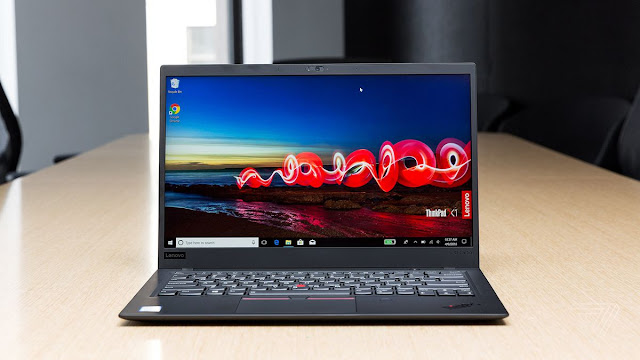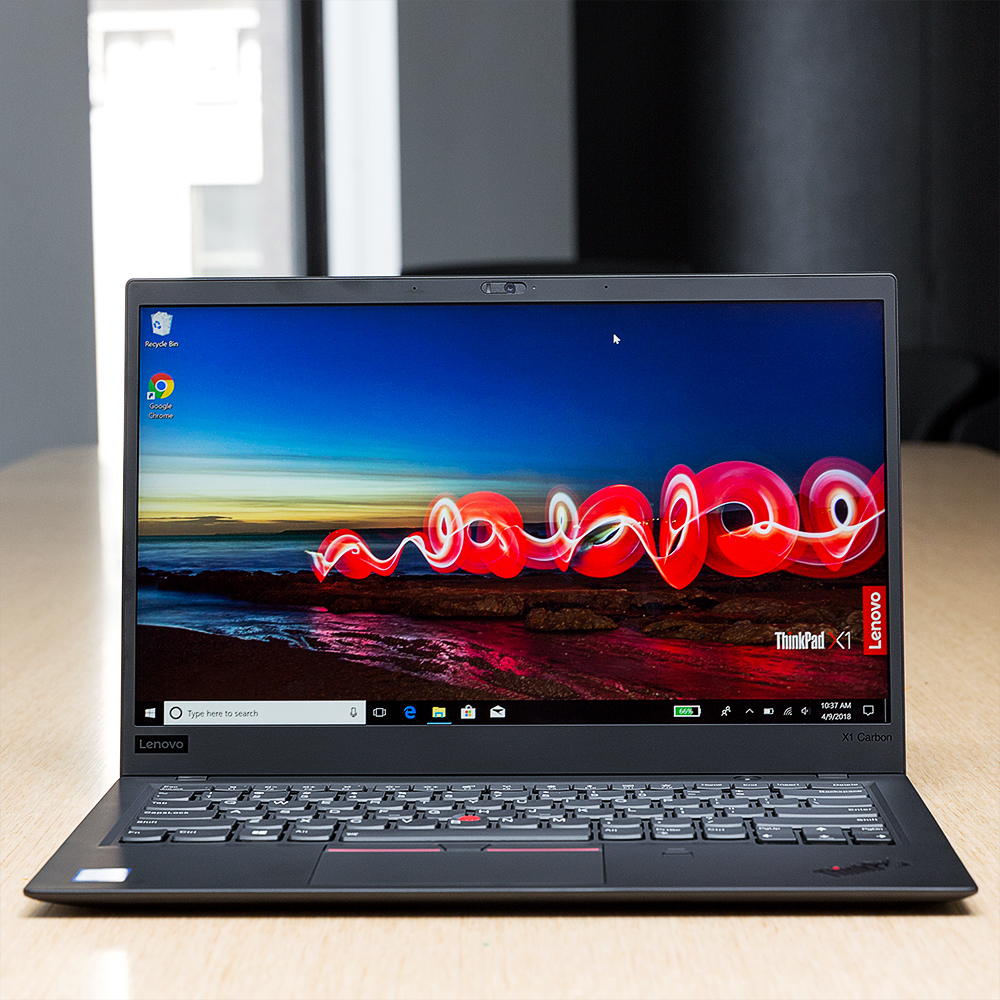Lenovo ThinkPad X1 Carbon (2018) review:
Lenovo ThinkPad X1 Carbon (2018) review:
There are few things more consistent in the tech world than ThinkPad laptops. For over 25 years, IBM and then Lenovo have been cranking out the utilitarian workhorses that put business needs first. Though ThinkPads have adopted new technologies and features over the years, they have had more constants — a conservative, blocky design; a keyboard made for lots of typing; that nubbin just above the B key — than changes, and you can draw a direct line from the first ThinkPad laptop to the ones that you can purchase today.
So it comes as no surprise that the new sixth-generation ThinkPad X1 Carbon is a business machine through and through. It has all of the usual ThinkPad hallmarks: comfortable, spacious keyboard; rugged, rubberized exterior; optional dock; and reliable performance and battery life. It also, of course, has the red eraser nub TrackPoint in the center of its keyboard for cursor and mouse control.
Compared to the wacky ideas of Microsoft or Apple or Google, who all seem bent on redefining what we consider a computer, ThinkPads are conservative and consistent. They know what they are and they aren’t here to convince you of anything new. As the flagship of the line, the X1 Carbon is perhaps the most ThinkPad of all ThinkPads. It’s peak ThinkPad.
/cdn.vox-cdn.com/uploads/chorus_asset/file/10618303/akrales_180409_2440_0026.jpg)
There are plenty of modern upgrades in this 2018 model: an eighth-generation Core i5 or i7 processor; Windows Precision trackpad; USB-C charging; far-field microphones for voice commands; and an optional touchscreen or HDR display (but unfortunately, not both at the same time). Put all of that together in the X1’s 2.5-pound, 16mm thick frame and you have the makings of a very attractive laptop for getting work done.
That combination will cost you, however. The X1 Carbon starts at just under $1,400, but thanks to a dizzying array of options and upgrades, it can be equipped to over $2,500.
Some of the options can be frustrating, too. If you want a touchscreen, you have to stick with the 1080p panel, which comes with a standard webcam. If you want a Windows Hello-compatible camera, you have to give up the touchscreen and upgrade to the 1440p display. But if you want the bright, beautiful Dolby Vision-capable HDR screen, you have to forgo the touch feature and the Windows Hello-compatible camera and make do with the not-very-good fingerprint scanner. The HDR screen also drops the anti-glare feature of the other display options, despite it being the most costly option.
At any rate, the model I’ve been testing for the past few weeks has an eighth-gen Core i5 processor; 8GB of RAM; a 14-inch, 1080p touchscreen display; 512GB of SSD storage; and a standard webcam. It’s the soft-touch black model, which looks as rugged as it is (Lenovo boasts of it passing a dozen military-grade certification tests, along with 200 in-house tests, and the keyboard is spill resistant), but also collects my fingerprints and skin oils readily.
Along each side of the laptop are a smattering of ports: two USB Type-C, a docking port, a USB Type-A, and an HDMI on the left; a headphone jack and another USB-A port on the right. Around back is a slot for a microSD card and where you’d put the SIM card for the optional integrated LTE modem.
All told, the unit I’m testing sells for $1,867 as configured, which feels like a rather high price for this set of specs. You can get a better-specced machine from HP or Dell for less, but one of the other ThinkPad hallmarks is that they aren’t cheap, so the price is not a huge surprise. You can also save a little by taking advantage of sales — at the time of publishing, this model is selling for $1,680.30 direct from Lenovo.
/cdn.vox-cdn.com/uploads/chorus_asset/file/10618309/akrales_180409_2440_0047.jpg)
/cdn.vox-cdn.com/uploads/chorus_asset/file/10618305/akrales_180409_2440_0044.jpg)
That configuration happens to work quite well for productivity needs. The display is color-accurate and bright, and its matte finish is great at eliminating the glare that plagues the glossy screens on many other laptops. It has trim bezels and the webcam is in the correct spot above the screen. I do wish that it offered a 3:2 aspect ratio, which is much more useful for productivity than the 16:9 screen is, but most people won’t have a problem with this.
The eighth-generation Intel processor is plenty enough for managing various programs at once, opening countless tabs in the browser, or pounding away at an enormous Excel spreadsheet. Though the processor is strong enough to handle any productivity task, the X1 Carbon doesn’t work silently — the fans come on often and are noticeable, jetting their exhaust on the right side of the laptop.
I’ve been averaging just over seven hours of battery life between charges with my daily workflow (lots of web browsing, email, Slack, writing in Word, video conferencing, and YouTube watching with brightness around 50 percent), which isn’t the best battery life, but likely enough for the average office drone that will be issued one of these for work. You could probably eke a bit more life out of the battery by futzing with Windows 10’s power management settings, but for my tests, I used it in the default state. Lenovo’s USB-C charger makes quick work of topping off the battery, too, charging it back up to 80 percent in just 60 minutes.
The X1 Carbon’s backlit keyboard is roomy and has great key travel, making it rather comfortable to type on. The keys are quiet, as well, though some might find them to be on the mushy side. My issue is more with the keyboard’s layout: Lenovo swapped the location of the Ctrl and Fn keys on the left side, which I’ve not been able to acclimate to, even after weeks of use. On the right side, there’s a Print Screen button jammed between the Alt and Ctrl key, which is less of a problem and just an odd place to put a Print Screen button.
/cdn.vox-cdn.com/uploads/chorus_asset/file/10618301/akrales_180409_2440_0032.jpg)
/cdn.vox-cdn.com/uploads/chorus_asset/file/10618313/akrales_180409_2440_0063.jpg)
Between the touchscreen, the touchpad, and Lenovo’s signature pointer nub, there is no shortage of ways to interact with Windows 10 on this X1. I never used the nub, but it didn’t get in my way and the people that want it will appreciate it’s there. The touchpad isn’t as big as you’d find on a MacBook Pro or other more consumer-focused laptops, but it works well and uses Microsoft’s Precision drivers for accurate tracking and multitasking gestures.
As I outlined above, this version of the X1 Carbon doesn’t have a Windows Hello compatible webcam, so it makes do with a fingerprint scanner positioned to the right of the touchpad. The scanner is not great — it’s slow to recognize my fingerprints and failed entirely on more than one occasion. The webcam is a typical 720p affair, but it does have a mechanical shutter, which lets you disable the camera and mic entirely, instead of resorting to putting tape over it for privacy. The switch can be hard to move, though, and personally, I’d rather just have a Windows Hello camera there for easier facial-recognition login.
/cdn.vox-cdn.com/uploads/chorus_asset/file/10618307/akrales_180409_2440_0053.jpg)






Post a Comment